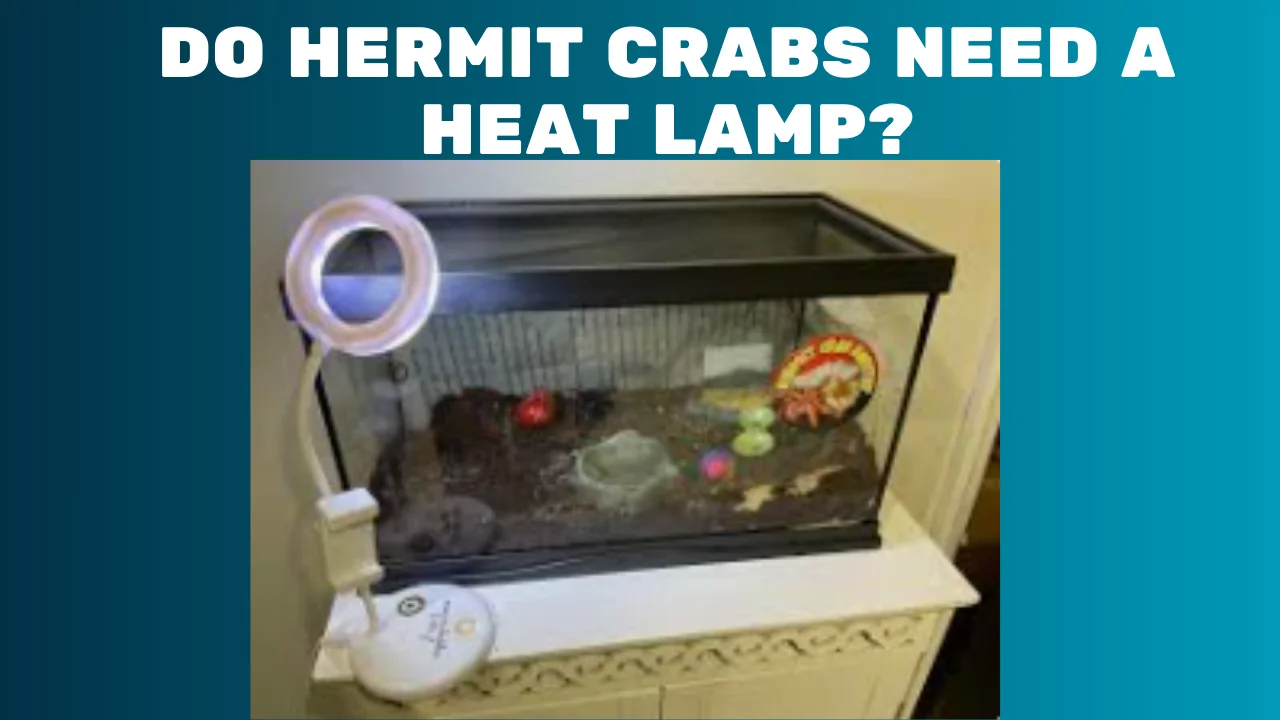Introduction
Many people who are interested in keeping pets choose hermit crabs because of the fascinating creatures they are and the fact that they live in mobile homes. However, it is essential to create an environment that closely resembles their natural habitat if you want these animals to remain healthy and flourish in captivity. The question of whether hermit crabs require a heat lamp arises because keeping the appropriate temperature is a crucial part of their habitat. So, do hermit crabs need a heat lamp?
Understanding Hermit Crab Needs
Learn the ins and outs of hermit crab care before you get into why a heat lamp is a must. Temperatures of 75 to 85 degrees Fahrenheit are typical for these crustaceans’ coastal habitats in tropical regions. For the sake of their health while kept in captivity, it is essential to replicate this warm and humid habitat.
Role of Temperature
When it comes to hermit crab health and behaviour, temperature is king. In their native environment, these organisms depend on temperature regulation of metabolic processes, which helps with digestion, shell selection, and general activity levels. During moulting, when hermit crabs remove their exoskeleton to make room for growth, it is extremely important to keep the temperature range at the correct level. Not having enough heat can make moulting more difficult, which can cause problems or even death.
Benefits of a Heat Lamp
Hermit crabs can be kept healthy in captivity by placing a heat lamp in their tank, which mimics the temperature of their native environment.
The natural behaviours of crabs, such as feeding, exploring, and resting, are promoted by a heat lamp that mimics the day-night cycle. This contributes to their overall well-being.
Hermit crabs can safely shed their exoskeletons and grow without problems if there is enough warmth during moulting.
Hermit crabs are able to digest their food more efficiently and stay in peak health because warmth helps with digestion.
Right Heat Source
No matter how important a heat lamp is, picking the correct heat source is just as crucial. Ceramic heat emitters and infrared bulbs are popular choices among hermit crab keepers because they provide heat without causing the crabs to lose their natural circadian rhythm. To avoid hot spots and maintain even heating, it is critical to place the heat source correctly inside the container.
Temperature and Humidity
Achieving the optimum temperature range is only one component of making a suitable habitat for hermit crabs; maintaining humidity is also important. Since these organisms rapidly dehydrate in dry conditions and breathe through modified gills, it is crucial to maintain an appropriate humidity level. To keep things running well, you need a heat lamp and something to add humidity, like a wet substrate or a misting system.
Creating a Balanced Environment
1. Monitoring Temperature and Humidity
It is crucial to regularly monitor the humidity and temperature levels in the hermit crab cage to make sure it stays in an ideal environment. If you’re a fan of hermit crabs, you should get some high-quality thermometers and hygrometers so you can monitor these factors closely and make adjustments as necessary to keep the crabs from getting stressed out.
2. Providing Thermal Gradients:
In addition to a heat lamp, incorporating thermal gradients within the enclosure is beneficial for hermit crabs. This entails making the habitat into zones of different temperatures so the crabs can control their own body temperature by hopping from one zone to another. Crabs can always find the perfect temperature for themselves if you provide them with both warmer and cooler spots.
3. Using Heat Mats or Heat Tape:
While heat lamps are the most common method of heating hermit crabs, some people choose to use heat mats or heat tape instead. These options can be set up under or next to the cage to provide hermit crabs with bottom-up heat, just like they would in the wild. For larger enclosures or for use during colder months, heat mats and tape can be especially helpful in maintaining consistent temperatures.
Preventing Heat Loss
1. Insulating the Enclosure
In colder regions, it can be helpful to insulate the hermit crab enclosure to keep heat in and temperatures stable. To improve energy efficiency and lessen the strain on the heat source, materials such as reflective insulation or polystyrene foam can be used to keep heat inside the enclosure.
2. Minimizing Drafts
Hermit crabs can easily have their habitat cooled down by drafts, rendering the heat source ineffective. In order to keep the crabs comfortable, it is important to place the cage in a draft-free area and seal any holes or cracks. This will help keep the temperature gradient constant.
3. Using Thermal Curtains or Cover
In addition to insulation, thermal curtains or covers can be used to further prevent heat loss from the hermit crab enclosure. An additional layer of protection against temperature fluctuations is provided by these specifically designed curtains or covers, which trap heat within the enclosure and keep the crabs cosy and comfortable.
Natural Light Cycles
1. Mimicking Daylight Hours
Hermit crabs, like many other creatures, have circadian rhythms that are affected by changes in the amount of light reaching their bodies. The crabs’ internal clocks are helped by creating an environment that mimics natural daylight hours within the cage. This helps them to have healthy activity patterns and rest periods. If you want to make sure that the light-dark cycle is consistent, use timers to control how long the heat lamp or other light sources stay on.
2. Providing Darkness for Rest
Hermit crabs require darkness for rest and recharge just as much as they need natural daylight. In order to ensure the crabs’ overall health and reduce stress, it is recommended to provide a period of darkness within the enclosure daily. This will allow the crabs to sleep undisturbed in their shells.
3. Avoiding Excessive Light Exposure
Hermit crabs need some light to keep their circadian rhythms in check, but too much light can be harmful. Crabs can live better in a more natural setting if they are not subjected to artificial light for long periods of time or to very bright lights.
FAQs
1. Do All Hermit Crabs Need Heat Lamps?
While hermit crabs can tolerate a range of temperatures, providing a heat lamp is highly recommended, especially in regions where ambient temperatures fall below the ideal range for these creatures.
2. What Is the Best Heat Source for Hermit Crabs?
Ceramic heat emitters and infrared bulbs are popular choices for hermit crab enclosures, as they provide consistent warmth without emitting disruptive light.
3. How to Maintain Proper Temperature for Hermit Crabs?
Regular monitoring with a thermometer is essential to ensure that the temperature within the enclosure remains within the optimal range. Adjustments may be necessary based on ambient conditions and seasonal changes.
4. Can Hermit Crabs Survive Without a Heat Lamp?
While hermit crabs may survive without a heat lamp, they are unlikely to thrive in suboptimal conditions. Providing a heat lamp helps mimic their natural habitat, promoting health and well-being.
5. How to Prevent Overheating in Hermit Crab Tanks?
To prevent overheating, it’s crucial to monitor the temperature regularly and adjust the heat source as needed. Additionally, providing adequate ventilation and ensuring proper positioning of the heat lamp can help maintain a balanced environment.
Conclusion
While hermit crabs may appear to be low-maintenance pets at first glance, it is important to take their temperature and humidity needs into account when designing their ideal habitat. In order to facilitate vital physiological processes and create an environment similar to their natural habitat, a heat lamp is an integral part of their habitat. Do hermit crabs need a heat lamp? Hermit crab enthusiasts can make sure these fascinating creatures thrive in captivity by providing the right warmth.

Shannon Reyes is a seasoned writer with a knack for crafting engaging blogs on a variety of service industries, including plumbing, cleansing, moving, pest control, and roofing. With a keen eye for detail and a passion for helping readers navigate complex topics, Shannon brings her expertise to life through informative and accessible content.










